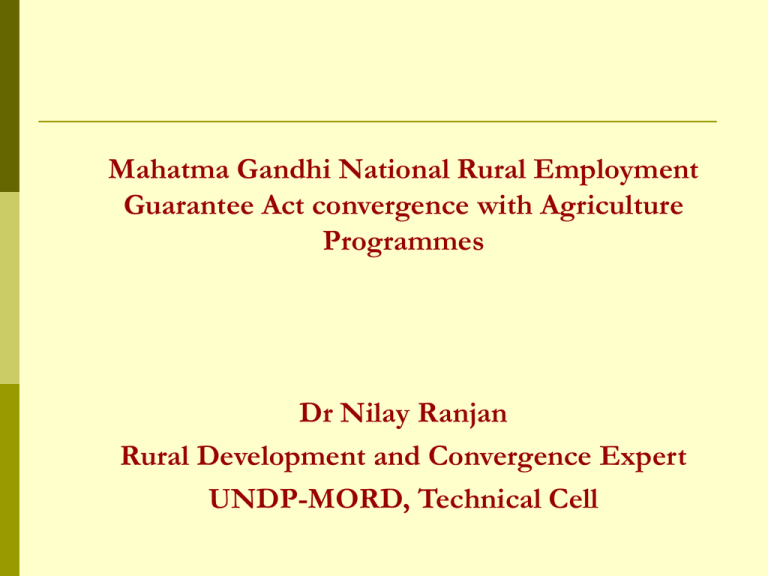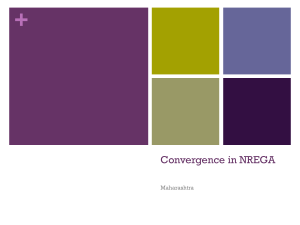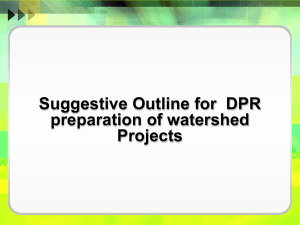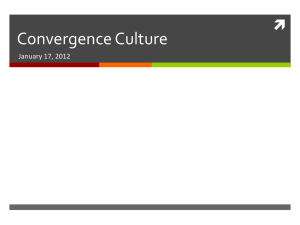Indian Agriculture - ACCESS Development Services
advertisement

Mahatma Gandhi National Rural Employment Guarantee Act convergence with Agriculture Programmes Dr Nilay Ranjan Rural Development and Convergence Expert UNDP-MORD, Technical Cell Presentation Overview Indian Agriculture-salient features Mahatma Gandhi National Rural Employment Guarantee Act (MGNREGA) Overview MGNREGA & convergence Initiatives taken by the states government Indian Agriculture: Salient Features 18% share of Agriculture in GDP 60% population dependent on Agriculture 121 million farm holdings (2001) Average size of operational holding: 1.3 ha. 82% of operational holdings small & marginal hectares) 60% of cultivated area is rainfed 18% landless agriculture labour (less than 2 Agricultural Growth Tot al GDP Agricult ure GDP (Per cent) 15 10 5 0 4.9 5.7 3.6 5.7 6.7 5.5 2.1 3.1 4.7 6.0 7.8 2.5 9.4 9.6 5.9 9.0 4.5 3.8 Vth VIth VIIth VIIIth IXth Xth 2005- 2006- 2007Plan Plan Plan Plan Plan Plan 06 07 08 Despite rising output, per capita availability of food grains has actually declined in the last ten years - from 500 gm a day in 1997 to about 400 gm a day currently. Agriculture Growth: More Adversely Affected in Rainfed Areas State Growth rate in NSDP Agriculture Rainfed % Gujarat 5.09 0.48 64 Rajasthan 5.52 0.30 70 32 Orissa 1.18 0.11 73 3.63 -0.23 74 Punjab 4.00 2.16 3 Haryana 4.60 1.98 17 1.87 % 1995/6 to 2004/5 1995/6 to 2004/5 2.82 Rainfed 1984/ 5 to 1995/ 6 1984/5 to 1995/6 Uttar Pradesh State Growth rate in NSDP Agriculture Tamil Nadu 4.95 -1.36 49 Madhya Pradesh West Bengal 4.63 2.67 49 Karnataka 3.92 0.03 75 6.66 0.10 83 -1.71 3.51 52 Maharashtr a Andhra Pradesh 3.18 2.69 59 Kerala 3.60 -3.54 85 All India 3.62 1.85 60 Assam 1.65 0.95 86 Bihar Mahatma Gandhi National Rural Employment Guarantee Act & Objectives 1. 2. 3. Providing wage employment opportunities Creating sustainable rural livelihoods through rejuvenation of natural resource base i.e. augmenting productivity and supporting creation of durable assets Strengthening rural governance through decentralisation and processes of transparency and accountability An Act to provide for the enhancement of livelihood security of the households in rural areas of the country by providing at least one hundred days of Guaranteed wage employment in every financial year to every household NREGA: Salient Features Right based Framework Time bound Guarantee of Employment Labour Intensive Works Payment of Wages through their Bank / Post Office accounts. Payment in any case not later than a fortnight Decentralisation: PRIs will have a principal role in planning, monitoring and implementation, GPs will execute at least 50% of works Women empowerment: At least one-third of the workers should be women Transparency & Accountability Proactive disclosure of information Social Audit by the Gram Sabha is mandatory Ombudsman to be set up Use of Information Technology A Web enabled MIS www.nrega.nic.in for monitoring, decision making and transparency Nature of Works Community Lands Water conservation Water harvesting Irrigation Drought proofing Plantation & Afforestation Renovation of water bodies Desilting of tanks & canals Flood control measures Rural connectivity Private Lands of SC/ST/IAY/Land Reform beneficiaries/BPL farmers Small & marginal farmers account for 80% of land- holdings & operate 40% of cultivated land Land Development Irrigation facilities Horticulture Plantation National Overview (FY 2006-07) 200 Districts Households Employment provided : PERSONDAYS [in Crore] Total: SCs: STs: Women: Others: Average personday per household FINANCIAL DETAIL Budget Outlay (In Rs Crore): Central Release (In Rs Crore): Total available fund with States [including OB]: In Rs. Crore. Expenditure (In Rs. Crore.) Average wage per day Average cost per day WORKS DETAIL Total works taken up (In Lakhs): Works completed: Water conservation: Provision of Irrigation facility to land owned by SC/ST/ BPL/ S & MF and IAY benificiaries: Rural Connectivity: Land Development: Bharat Nirman Rajiv Gandhi Seva Kendra Any other activity: (FY 2007-08) 330 Districts (FY 2008-09) 615 Districts (FY 2009-10) 619 Districts (FY 2010-11) 625 Districts upto Sep 2010 2.10 Crore 3.39 Crore 4.51 Crore 5.25 Crore 3.52 90.5 22.95 [25%] 32.98 [36%] 36.79 [41%] 34.56 [38%] 43 Days 143.59 39.36 [27%] 42.07 [29%] 61.15 [43%] 62.16 [43%] 42 Days 216.32 63.36 [29%] 55.02 [25%] 103.57 [48%] 97.95 [45%] 48 Days 282.58 86.31 [31%] 58.57 [21%] 137.40 [49%] 137.69 [49%] 54 Days 115.03 26.15 [23%] 19.51 [17%] 59.61 [52%] 69.38 [60%] 33 Days 11300 8640.85 12073.55 12000 12610.39 19305.81 30000 29939.60 37397.06 39100 33506.61 49529.99 40100 22488.16 36126.07 8823.35 Rs. 65 Rs. 97 15856.89 Rs. 75 Rs. 110 27250.10 Rs. 84 Rs. 126 37938.16 Rs. 91 Rs. 134 15133.48 Rs. 96 Rs. 132 8.35 3.87 4.51 [54%] 0.81 [10%] 17.88 8.22 8.73 [49 %] 2.63 [15 %] 27.75 12.14 12.79 [46%] 5.67 [20%] 46.01 20.94 23.33 [51%] 7.77 [17%] 63.45 1.46 32.23 [51%] 7.17 [11%] 1.80 [21%] 0.89 [11%] 0.34 [4%] 3.08 [17 %] 2.88 [16%] 0.56 [3%] 5.03 [18%] 3.98 [15%] 0.28 [1%] 7.63 [17%] 13.50 [21%] 6.29 [14%] 7.93 [13%] 0.17 9[0.27%] 0.98 [2%] 2.44 [4%] Highest Priority to Water Conservation in Choice of Works under NREGA: Financial Year 2010-11 upto sep, 10 Flood Control and Protection 9% 3% Water Conservation and Water Harvesting 6% 27% 8% 1% Provision of Irrigation facility to Land Owned by SC/ST/BPL/ IAY Beneficiaries Rural Connectivity Land Development Others 13% Drought Proofing (Afforestation & Plantation) 16% Micro Irrigation Works 16% Renovation of Traditional Water bodies NATIONAL Share of works on private lands [provision of irrigation facilities to land owned by SC/SC/IAY/BPL/Small and Marginal Farmer beneficiaries] 25 20 15 10 5 0 2006-07 2007-08 2008-09 2009-10 NREGA: Positive Trends Increase in Agriculture Minimum Wages and wage earned per day and annual income. Bargaining power of labour has increased Earnings per HH has increased from Rs 2795 in 2006-’07 to Rs 3150 in 2007-’08 to Rs 4060 in 2008-’09 and about Rs 3500 in the current FY, 5000 in 2009-10 Financial Inclusion: 9.3 crore accounts opened Distress migration has reduced in many parts “Green Jobs” created as 70% works relate to water conservation, waterharvesting, restoration, renovation and desilting of water bodies, drought-proofing, plantation & afforestation Productivity effects of NREGA reported - Improvement in ground water - Improved agricultural productivity & cropping intensity - Livelihood diversification in rural areas. 12 Inter-sectoral Convergence for creation of Durable and Productive Assets From mere wage employment to sustainable rural livelihoods From unskilled to skilled labour through knowledge & technology input, training & capacity building in productivity increases, water-use efficiency, backward–forward linkages Significant productivity increases could be stimulated by NREGA on holdings of small and marginal farmers in rainfed areas Parameters for Convergence A process that brings together on-going schemes Guidelines are a broad facilitating framework Parameters of NREG Act and Guidelines as well as the guidelines of the other development Schemes with which convergence is attempted are not altered. Convergence is expected to create value addition through resource and activity synergies as well as infusion of technology input and professional quality in planning and implementation Joint monitoring of Convergence Convergence at planning, management and works level 14 14 14 Joint Guidelines on convergence of MGNREGS with specific programmes & schemes Ministry of Agriculture -- Indian Council of Agricultural Research Ministry of Environment and Forest Ministry of Water Resources Department of Land Resources Pradhan mantri Gram Sadak Yojana – Rural Roads SGSY (Department of Rural Development) Ministry of Agriculture Convergence Guidelines with Schemes of Ministry of Tribal Affairs and watershed under progress Pilots Projects on convergence in selected districts taken up like action research identifying further possibilities and upscaling. Funding will be through MGNREGA and concerned programmes 15 MGNREGS and Schemes of Ministry of Agriculture NREGA works catalyse agricultural development through: • Additional land under irrigation/cultivation • Improved soil fertility and moisture conservation • Convergence with NHM, RKVY, NFSM, Fisheries etc • Growth in consumption of agricultural inputs through increased household earnings So huge potential exists for NREGA convergence with agriculture and allied programmes such as; • National Horticulture Mission • Rashtriya Krishi Vikas Yojana • National Food Security Mission • Inland Fisheries and Aquaculture Development • National Agriculture Innovation Project • Intensive Dairy Development Programme 16 MGNREG Convergence with RKVY • Developing of rain fed farming systems in and outside watershed areas, as also integrated development of watershed areas, wastelands, river valleys •Activities relating to enhancement of horticulture production and popularization of micro irrigation systems; •Collection and processing of neem seeds as part of Integrated Pest Management • Promote Organic farming through extensive composting and recycling of solid waste • Seed production, packing and processing in common and community lands • Common post harvest facilities for threshing, storage and labour intensive processing 17 MGNREGS with National Food Security Mission National Food Security Mission (NFSM) The objective of the Mission • Increase production of rice, wheat and pulses through area expansion and productivity enhancement in a sustainable manner in the identified districts • Restoring soil fertility and productivity at the individual farm level • Creation of employment opportunities; and enhancing farm level economy ( i.e. farm profits) to restore confidence amongst the farmers. Value addition to NREGS work through NFSM Individual land holding cultivators benefiting under NREGS should be included under NFSM on priority, for value addition through sharing of information: Critical role of ATMA 18 MGNREGS and Scheme on Development of Inland fisheries and aquaculture Activities under Fisheries schemes i) Construction of new ponds ii) Reclamation/Renovation of ponds/tanks iii) Fish Seed Hatchery iv) Aerators/Pumps v) Training of fish farmers vi) Provision of soil and water testing kits to each FFDA Activities that may be undertaken under NREGS I and ii Convergence with Programmes of Ministry of Forest and Environment and MGNREGS for Eco restoration Root stock regeneration, new plantation and Silvipasture Fencing Land Development to rehabilitate degraded forest Forest fair weather Roads Water Conservation National Afforestation Programme Implementation agencies: Joint Forest Management Committees 20 Convergence of Programmes of Ministry of Water Resources For Effective Water conservation and efficient Water use Artificial Recharge of Ground Water through Dug well Repair, Renovation and Restoration of water bodies directly linked to Agriculture/ Aquaculture Accelerated Irrigation Benefits Programme Flood Management Programme Farmer’s Participation Action Research Programme Command Area Development & Water Management Programme Value Addition: The work of Canal plantation and Canal fair weather road may be carried out under NREGA as value addition. 21 21 Convergence with Watershed Programmes Guidelines Issued Project of a village to be prepared on Watershed approach Delineation of Watershed as per Common guidelines for Watershed Under NREGA, the size can be an area of the village matching micro watershed i.e. nearly 250 to 500 hectares. Gap Filling through NREGA a) Areas treated under Watershed Development programme but not saturated because of insufficient cost norms. b) Difficult areas, being treated under the watershed Development programme, where the revised cost norms is also not sufficient to saturate the area. c) New areas; neither yet treated nor planned under watershed programme and where works are to be planned on watershed approach under NREGA. 22 Triggering Green Revolution in Rainfed Areas Green Revolution bypassed the rainfed areas. Agriculture Development Programmes and MGNREGS converged have potential to become a life-support system in the rainfed areas Most MGNREGA works contribute directly or indirectly to agricultural development Convergence of MGNREGA with agriculture and allied sectors is possible across the value chain; o Pre-production - Soil and water conservation projects form bulk of MGNREGA works o Production phase – Weed control in common lands, community nurseries for planting material o Post harvest – Common threshing floors, village roads for connectivity to markets, composting post harvest waste Convergence of MGNREGS with Schemes of Ministry of Agriculture can improve soil health & water conservation 23 Non -Negotiables in work execution: Only Job Card holders to be employed for NREGA component. Muster rolls to be maintained on work site, with copies in the gram panchayat and to be electronically maintained on nrega.nic.in Social Audits to be done through gramsabhas. Wage payments will be through no frills accounts in banks/post office 24 Working models, convergence Working Model: Orissa, Mayurbhanj, Ganjam Convergence: Model I Community Tank under NREGS Fishery through SHGs Horticulture & Plantation Irrigation & Water Conservation Convergence: Model II Irrigation Watershed Development under NREGS Fishery through the SHGs Social Forestry Plantation & Horticulture Animal Husbandry Soil and Water Conservation Convergence: Model III Rural Connectivity under NREGS Water Conservation Plantation Conversion into Pucca Road through PMGSY Selected Villages in Mayurbhanj District Identified Villages/GPs for MGNREGS Convergence in Mayurbhanj District and Activities undertaken S.N. 1 2 3 4 Name of Block Morada Bangiriposi Samakhunta Kuliana Name of Gram Panchayts(GPs) Village Major Activities Departments involved (i) Farm Pond-HorticulturePisciculture-Poultry-irrigation (ii) Community TankPisciculture-Horticulture-Irrigation (i) Horticulture, Fishery, KVK, Agriculture (ii) Horticulture, Fishery, KVK, Agriculture, SGSY Sureidihi Chakundapada Bhaliadiha Kalarafulia Farm Pond-Horticulture-PisciculturePoultry-irrigation Horticulture, Fishery, KVK, Agriculture Surisapal Kanchinda Farm Pond-Horticulture-Piscicultureirrigation Horticulture, Fishery, Agriculture Budhikhamari Budhikhamari Community Tank-Fishery-Horticulture Fishery, Horticulture, Veterinary (i) Horticulture, Fishery, KVK, Agriculture (ii) Horticulture, Fishery, KVK, Agriculture Paikabasa Harischandrapur (i) Farm Pond-HorticulturePisciculture-Poultry-irrigation (ii) Community TankPisciculture-Horticulture-Irrigation Rangamatia Kundalbani Farm Pond-Pisciculture-irrigation Baiganabadia Balipal Farm Pond-Horticulture-PisciculturePoultry-irrigation Horticulture, Fishery, KVK, Agriculture, SGSY Nodhana Nodhana Farm Pond-Horticulture-PisciculturePoultry-irrigation Horticulture, Fishery, KVK, Agriculture, SGSY Fishery, Agriculture Selected Villages in Ganjam Districts Identified Villages/GPs for MGNREGS Convergence in Ganjam District and Activities undertaken S.No Name of Block Name of Gram Panchayts (GPs) Village Major Activities Departments involved Hinjlicut Saru Saru Tank-Pisciculture- Plantation-Irrigation Fisheries, Irrigation, Horticulture, KVK Darubhadra Darubhadra Tank-Pisciculture- Plantation-Irrigation Fisheries, Irrigation, Horticulture, KVK Biswanathpur Biswanathpur Tank-Irrigation-Plantation-Rural connectivity Horticulture, Irrigation, Fishery, Agriculture-KVK Chikrada Chikrada Tank-PlantationPiscicultur-/Horticulture Fisheries, Horticulture, Irrigation, Agriculture-KVK Sheragada Ramagiri Tank-Plantation Fisheries, Horticulture, AgricultureKVK Karadakana Karadakana Tank-Poultry farm-Rural connectivityPlantation Fisheries, Horticulture, AgricultureKVK T. Govindpur Khaprabar Rural connectivity-Tank-Watershed Development- Forestry-Plantation Horticulture, PMGSY, Fisheries, Forest, Water Resources, Agriculture-KVK, Singipur Harina Rural Connectivity- Tank-PlantationWatershed DevelopmentHorticulture-Forestry Horticulture, PMGSY, Fisheries, Forest, Water Resources, Agriculture-KVK . 1 2 3 4 Rangeilunda Sheragada Sana-Khemundi Major Findings: Perceptions of Line Department Officials Difficulties Faced by the Line Departments FISH. DEPT FOREST DEPT MI DEPT LACK OF CORDINATION AND INFORMATION LACK OF PROPER PLANNING WR DEPT LACK OF COOPERATION FROM PRIs LACK OF COORDINATION PR DEPT Total Model Convergence Khaprabar village under T. Gobindpur Panchayat Tribal Village consisting of 20 households Major Occupation: Cultivation Forest collection Convergence Initiative: Fish Pond, Irrigation, Plantation, Horticulture Model Convergence Fish Pond Model Convergence Paddy Field and Fruit Bearing Trees Good Practices & Innovations 35 Banaskanttha District Infrastructure Development: • Open/close drainage line • Stone pitching in pond (On going) Livelihood: • Horticulture through waste water management Banaskantha District @ Vadgam @ village Meetha 36 •Asset/s Created: Horticulture and Seasonal Vegetable Plantation •Immediate Benefits: Employment generation •Asset Durability: Very high •Possible Impact: Livelihood enhancement, Promotion of recycling technology and wasteland development The farmers can easily earn Rs. 4000-6000 per month Dang District @ Ahawa @ village Shamgatan 37 • • • • • • Convergence Activity: Bhagat Udyan Convergence Dept.: Forest Asset/s Created: Plantations of Indigenous Medicines Immediate Benefits: Assured employment for the poor, assured wages, recycling of resources Asset Durability: Very high Possible Impact: Livelihood enhancement, Promotion and conservation of indigenous medicines and practices Replicable Success Stories/Good Practices Plantation in Chaukati Village Plantation at Nakati Hills A Privately Owned Nursery under NREGA in village Kayethapara Water Conservation Tank in Srijangram Development Block Construction of earthen bundh and palliative measures at eroded portion at Char area Construction of bundh from Champa bridge to Baghmara village with cross drainage • Plantation of Banana in Alukhanda Village Pineapple Plantation in Mulagaon GP Kerala, Mammalpuram NREGS convergence in Agriculture 282 works have been carried out with an expenditure of 97 lakh rupees. Around 600 hectares of land got benefited Agriculture works in Monitoring Blocks Block Tirur Ponnani Nilambur Kuttipuram GP Thalakkad No of Works Area in Ha Expenditure 3 6 48,000 Trippangode 12 25 2,76,000 Edappal 31 12.5 7,37,000 Thavanur 34 13.18 10,06,000 Chungathara 5 61 10,75,000 Kuttipuram 1 19 2,32,853 Irimbiliyam 36 87 16,78,853 NREGS Convergence with Agricultural Farms NREGS involvement in Six Agricultural Farms Focus on production of quality seeds One Agricultural Farm in the Monitoring GPs In dire situation due to shortage of funds and labour Most of the land unutilized – production reduced NREGS in land development activities – freed technical labour for skilled work In 2008-09, Rs. 2,04,461 were spent, utilising 1570 persondays Gone up to Rs. 11,91,003 in 2009-10 with 8862 NREGS Convergence with KVK KVK in Malappuram participated in NEW Delhi meeting of 29th April 2009 (convergence with ICAR) DRDA-KVK meeting to train SGSY beneficiaries, technological demonstrations, skill development NREGS involvement in KVK farm’s land development In 2008-09, 717 persondays, 1.5 lakh rupees In 2009-10, works carried out in three reaches – 2378 persondays, Rs. 2,98,728 of Expenditure KVK involvement in horticulture Development NREGS-Forest Department Convergence 758 sq. kms of forest land in Malappuram District Significant Forest areas in Nilambur Blokc Two Forest Divisions Operating from Nilambur Town Vetiver plantation in Vazhikkadavu-Nadukani pass which located in Highway connecting Kerala with Tamilnadu A total of 5697 persondays and Rs. 12,41,536 were used for this project under NREGS in 2008-09 in 2009-10 the expenditure gone up to Rs. 15,70,314 Much scope to increase convergence with Forest Department 220 ST colonies in Nilambur Block Proactive Approach at State Level – Availability of Guidelines Man-Animal Conflict Implementation of NAP ntations & bunding: Kerala Nursery, Bilaspur Forest Division, Chhattisgarh Water pond for orchards , Jammu & Kashmir Dug Well, Madhya Pradesh Check Dam , Jammu & Kashmir Conservation and Afforestation of forest area: Water, Fodder, Water Tank and Nursery Gujarat After restoration Water Conservation Tank, Andhra Pradesh








